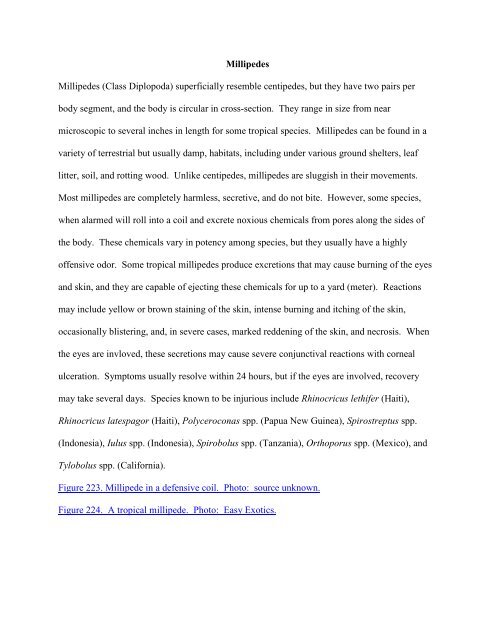Field Guide to Venomous and Medically Important Invertebrates ...
Field Guide to Venomous and Medically Important Invertebrates ...
Field Guide to Venomous and Medically Important Invertebrates ...
Create successful ePaper yourself
Turn your PDF publications into a flip-book with our unique Google optimized e-Paper software.
Millipedes<br />
Millipedes (Class Diplopoda) superficially resemble centipedes, but they have two pairs per<br />
body segment, <strong>and</strong> the body is circular in cross-section. They range in size from near<br />
microscopic <strong>to</strong> several inches in length for some tropical species. Millipedes can be found in a<br />
variety of terrestrial but usually damp, habitats, including under various ground shelters, leaf<br />
litter, soil, <strong>and</strong> rotting wood. Unlike centipedes, millipedes are sluggish in their movements.<br />
Most millipedes are completely harmless, secretive, <strong>and</strong> do not bite. However, some species,<br />
when alarmed will roll in<strong>to</strong> a coil <strong>and</strong> excrete noxious chemicals from pores along the sides of<br />
the body. These chemicals vary in potency among species, but they usually have a highly<br />
offensive odor. Some tropical millipedes produce excretions that may cause burning of the eyes<br />
<strong>and</strong> skin, <strong>and</strong> they are capable of ejecting these chemicals for up <strong>to</strong> a yard (meter). Reactions<br />
may include yellow or brown staining of the skin, intense burning <strong>and</strong> itching of the skin,<br />
occasionally blistering, <strong>and</strong>, in severe cases, marked reddening of the skin, <strong>and</strong> necrosis. When<br />
the eyes are invloved, these secretions may cause severe conjunctival reactions with corneal<br />
ulceration. Symp<strong>to</strong>ms usually resolve within 24 hours, but if the eyes are involved, recovery<br />
may take several days. Species known <strong>to</strong> be injurious include Rhinocricus lethifer (Haiti),<br />
Rhinocricus latespagor (Haiti), Polyceroconas spp. (Papua New Guinea), Spirostreptus spp.<br />
(Indonesia), Iulus spp. (Indonesia), Spirobolus spp. (Tanzania), Orthoporus spp. (Mexico), <strong>and</strong><br />
Tylobolus spp. (California).<br />
Figure 223. Millipede in a defensive coil. Pho<strong>to</strong>: source unknown.<br />
Figure 224. A tropical millipede. Pho<strong>to</strong>: Easy Exotics.

















